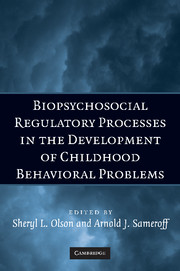Book contents
- Frontmatter
- Contents
- Preface
- Contributors
- 1 Conceptual Issues in Studying the Development of Self-Regulation
- 2 How Gene-Environment Interactions Can Influence the Development of Emotion Regulation in Rhesus Monkeys
- 3 Context Matters: Exploring Definitions of a Poorly Modulated Stress Response
- 4 An Integrative Approach to the Neurophysiology of Emotion Regulation: The Case of Social Withdrawal
- 5 Regulatory Competence and Early Disruptive Behavior Problems: The Role of Physiological Regulation
- 6 Behavior Regulation as a Product of Temperament and Environment
- 7 Self-Regulatory Processes in the Development of Disruptive Behavior Problems: The Preschool-to-School Transition
- 8 Emotional Dysregulation and the Development of Serious Misconduct
- 9 Regulatory Processes in Children's Coping with Exposure to Marital Conflict
- 10 Family Subsystems and Children's Self-Regulation
- 11 Culture and the Development of Regulatory Competence: Chinese–U.S. Comparisons
- 12 Self-Regulation and the Development of Behavioral and Emotional Problems: Toward an Integrative Conceptual and Translational Research Agenda
- Index
- References
4 - An Integrative Approach to the Neurophysiology of Emotion Regulation: The Case of Social Withdrawal
Published online by Cambridge University Press: 02 July 2009
- Frontmatter
- Contents
- Preface
- Contributors
- 1 Conceptual Issues in Studying the Development of Self-Regulation
- 2 How Gene-Environment Interactions Can Influence the Development of Emotion Regulation in Rhesus Monkeys
- 3 Context Matters: Exploring Definitions of a Poorly Modulated Stress Response
- 4 An Integrative Approach to the Neurophysiology of Emotion Regulation: The Case of Social Withdrawal
- 5 Regulatory Competence and Early Disruptive Behavior Problems: The Role of Physiological Regulation
- 6 Behavior Regulation as a Product of Temperament and Environment
- 7 Self-Regulatory Processes in the Development of Disruptive Behavior Problems: The Preschool-to-School Transition
- 8 Emotional Dysregulation and the Development of Serious Misconduct
- 9 Regulatory Processes in Children's Coping with Exposure to Marital Conflict
- 10 Family Subsystems and Children's Self-Regulation
- 11 Culture and the Development of Regulatory Competence: Chinese–U.S. Comparisons
- 12 Self-Regulation and the Development of Behavioral and Emotional Problems: Toward an Integrative Conceptual and Translational Research Agenda
- Index
- References
Summary
The concept of emotion regulation as a psychological construct has become an issue of significant scientific debate during the last decade (see Cole, Martin, & Dennis, 2004). Recent conceptualizations of emotion regulation have ranged from “changes associated with activated emotions” (Cole et al., 2004. p. 320) to emotion regulation as embedded in emotion or as an integrated component of emotional processes, including the generation, manifestation, and termination of the emotional experience (Campos, Frankel, & Camras, 2004). Because of the integrative nature of the physiological processes involved in the perception, processing, and reaction to emotional stimuli,we agree with Campos et al.'s (2004) working definition of emotion regulation. We view emotion regulation as a chain of neurocognitive processes that modulate the activation, intensity, duration, quality, and expression of emotional experience. At their most basic form, these processes are in charge of the processing of emotional stimuli and the subsequent regulation of arousal (Bradley, 2000).
Although theorists have called for a “process” model of emotion regulation (Campos et al., 2004), empirical validation of this model has been limited. One barrier to progress has been the lack of well-articulated processes involved in emotion regulation and of cohesive theoretical formulations that account for the highly interconnected nature of these processes. One example of this process model can be observed in children's reactions to fear-inducing stimuli. In our laboratory, we perform a brief fear-inducing task during which children are exposed to a realistic rubber snake. The reaction to such stimuli varies significantly.
- Type
- Chapter
- Information
- Biopsychosocial Regulatory Processes in the Development of Childhood Behavioral Problems , pp. 57 - 85Publisher: Cambridge University PressPrint publication year: 2009
References
- 1
- Cited by



